For any passionate trekker, the Annapurnas Tower is the mythical trek to realize once in his life.
Who likes trek can't ignore Nepal. This is not a quote from Edmund Hillary, but the message remains true! The Tour des Annapurnas is El Capitan of the trekker. If the Everest base camp trek is also mythical for the symbol it represents, the Annapurnas circuit has the advantage of passing the hiker through a wide variety of landscapes. Making a trek in Nepal will have the advantage of satisfying the sporting traveller like the barider eager for human exchanges. It is also a country of great cultural richness. Technically interesting and aesthetically grandiose, this hike is a must for a sporting holiday in Nepal.
Ready to take your eyes, heart and feet?
The Tour des Annapurnas: in the footsteps of the Himalayas
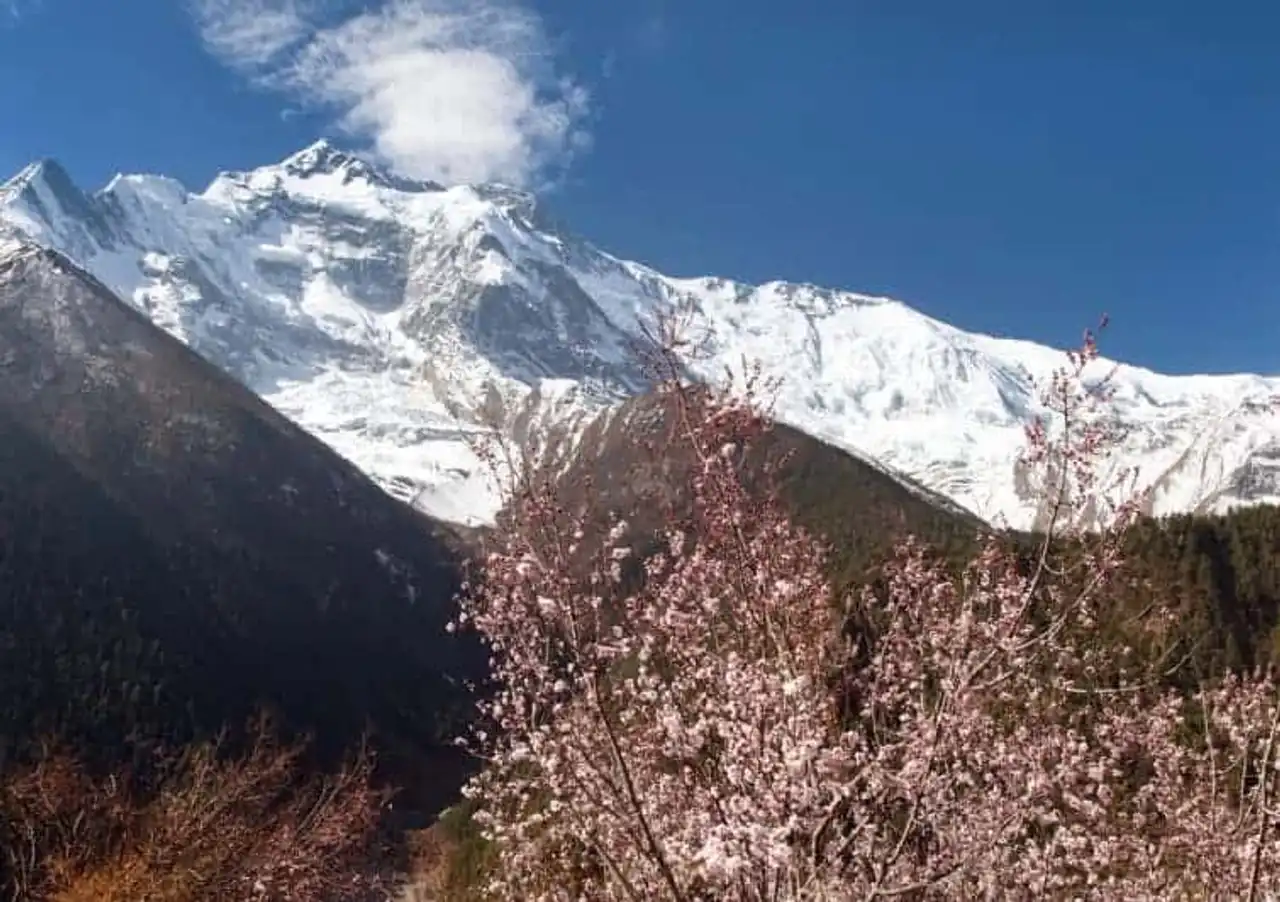
Photo credit: Shutterstock / Daniel Prudek
The Annapurna massif is located in the heart of the Himalayas, a hundred kilometres northwest of Kathmandu. One might believe that there is only one summit named Annapurna. Yet they are five, which explains the use of the plural in the name given to the Trek of the Tour des Annapurnas. The highest peak exceeds the eight thousand metres, placing it in the tenth position of the highest peaks in the world. This is Annapurna I. The Annapurna massif also houses other giants, such as the Gangapurna, which reaches 7,455 m, and the famous Machhapuchhre, on which one cannot walk, because of its sacred character.
Mauritius Herzog and his expedition of 1950 were the first to reach a summit of more than eight thousand meters, that of Annapurna I. The Tour des Annapurnas does not drive as high, but allows for an overview of the massif.
Why trekker in the Annapurna massif?
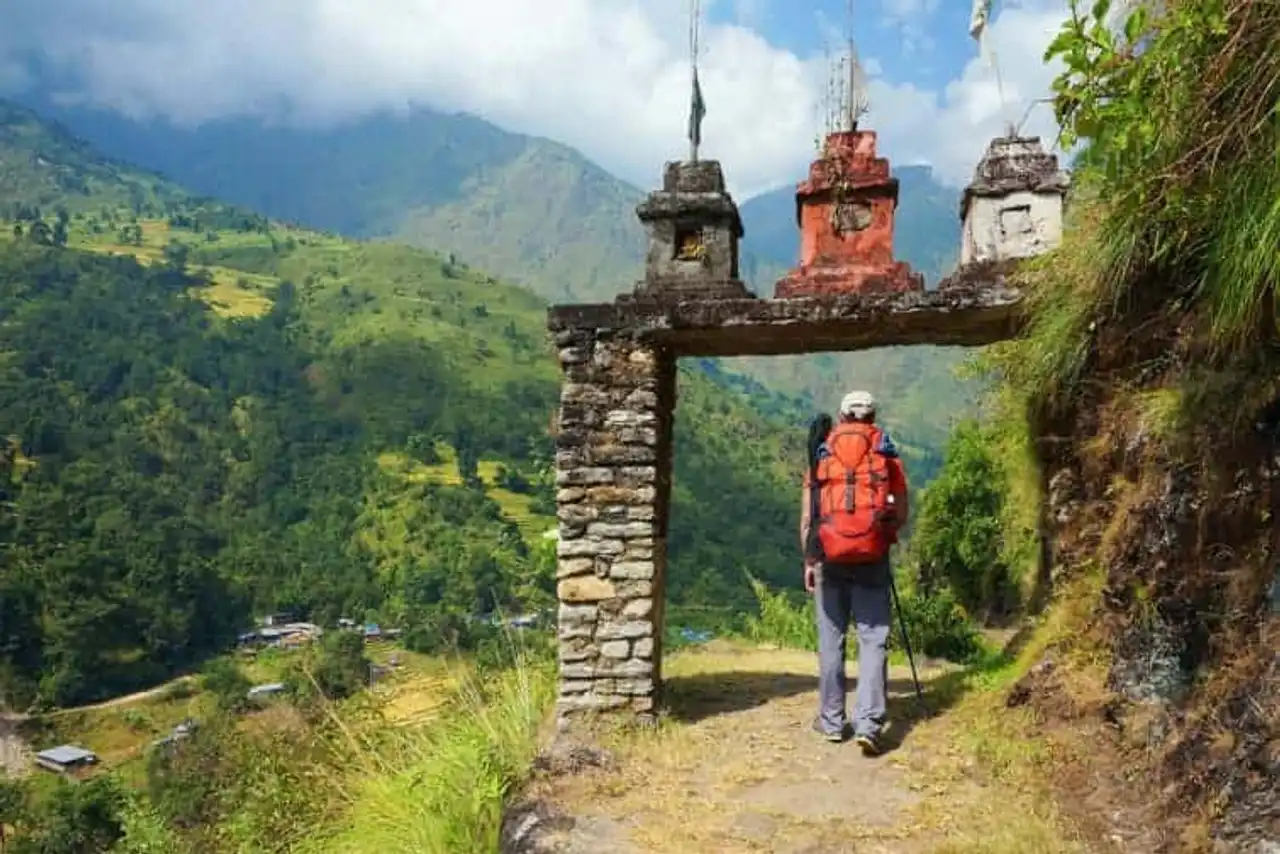
Photo credit: Shutterstock / Moroz Nataliya
The Tour des Annapurnas is not only one of the most beautiful treks in the world , by the sumptuous and diversified landscapes it gives to see. It is also a human and cultural adventure, meeting a people and a very singular history. Trekker in the Annapurnas is to combine an ideal and unique walking environment, while giving the opportunity to question the world and its values. Doing a trek in Nepal, and the Tour des Annapurnas in particular, leaves traces, because what you will see will be wonderful and what you will live there will be intense.
You will enter the most remote villages in the country where families, children have a daily life and beliefs to share. You will cross pine forests, walk along terraced cultures, climb snowy mountain slopes. You will take several centuries old stone stairs, pass under garlands of prayer flags, meet children leaving for school. You'll overlook Lake Tilicho , cross donkeys and mules, cross rivers, etc. Convinced? Here we go!
Our advice to prepare well for the Tour des Annapurnas
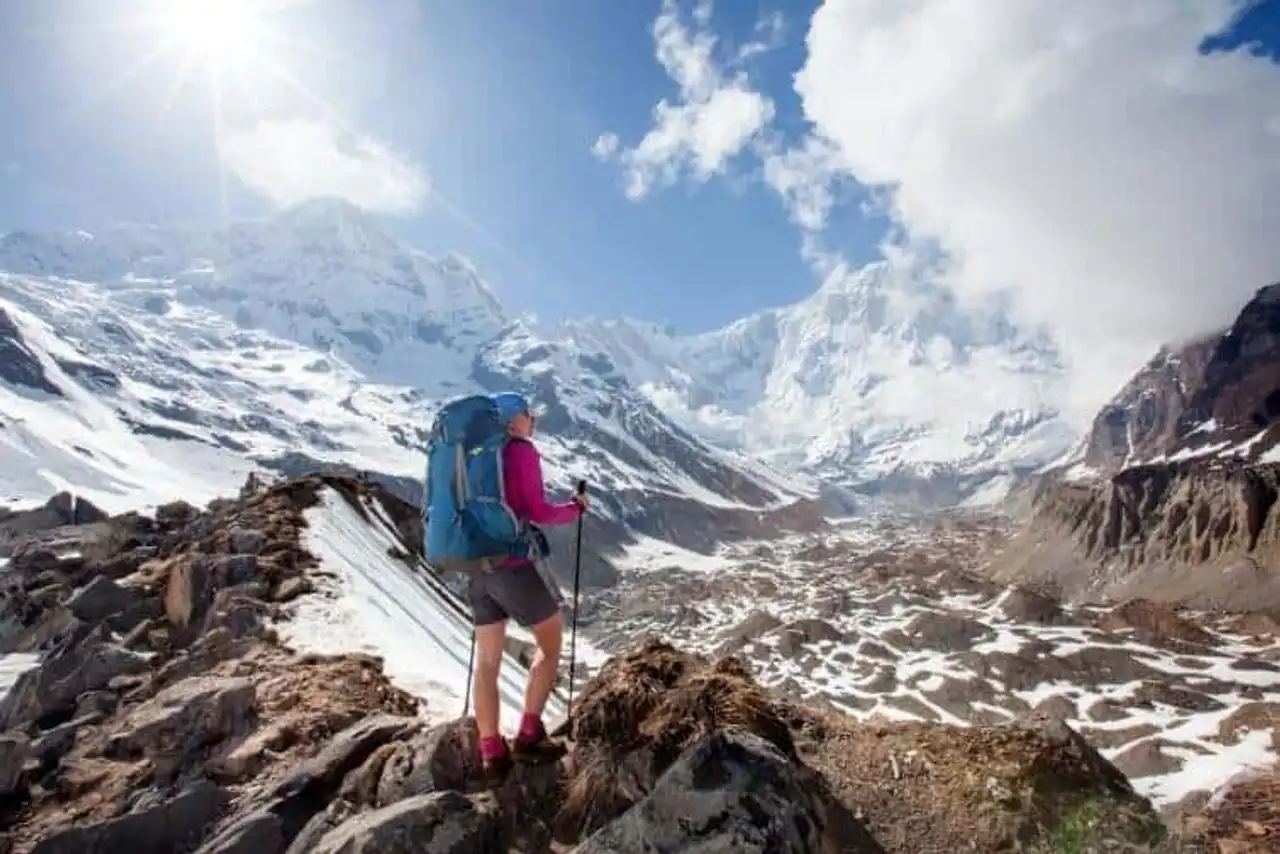
Photo credit: Shutterstock / My Good Images
The trek of the Tour des Annapurnas is a trek about 220 km, medium to difficult difficulty. At the start of Paris, count between thirteen and nineteen days, to make this long hike. In pure walking, the trek can be done between nine days and twelve days.
The best period
The best time to make the Tour des Annapurnas trek is between March and May, and also in November. Avoid, preferably, the months of June, July and August, which are monsoon months. In winter, if it’s nice to have less tourists, it’s a shame to have to remove some stages because of the snow.
What should I take in my backpack?
When we do a trek in Nepal, the best is avoid overloading. If you have a sherpa, also think of him, and don't go with your house in your bag! Be reasonable, while being well equipped.
Clothing:* compressible doudoune;
- flexible hiking pants;
- breathable warm coat;
- high-tech with breathable long sleeves;
- breathable t-shirt;
- breathable fleece jacket;
- three good pair of socks;
- three underwear;
- pair of sunglasses;
- cup;
- cap;
- polar cache;
- gloves;
- good walking shoes;
- Rain cape.
Equipment:* 40 L day backpack if you wear your big 60-70 bag L
- filtering dildo or a simple dildo with Micropur watermelons;
- Saw knife;
- sleeping bag and a fleece bag;
- frontal lamp;
- adapter;
- camera, bag, battery, sd cards, etc.;
- map of the trek of the Tour des Annapurnas;
- waterproof pouch with your identity papers;
- pair of telescopic sticks.
Hygiene and health:* coca in homeopathy, against acute mountain disease, or an antalgic;
- anti-diarrhoea;
- small laundry tube to wash your clothes or underwear;
- toothbrush, toothpaste, soap;
- small towel;
- lip balm;
- toilet paper and handkerchiefs;
- sun cream;
- Some cereal bars to get you back!
Once your luggage is ready, let the adventure begin!
What to see and what to do?
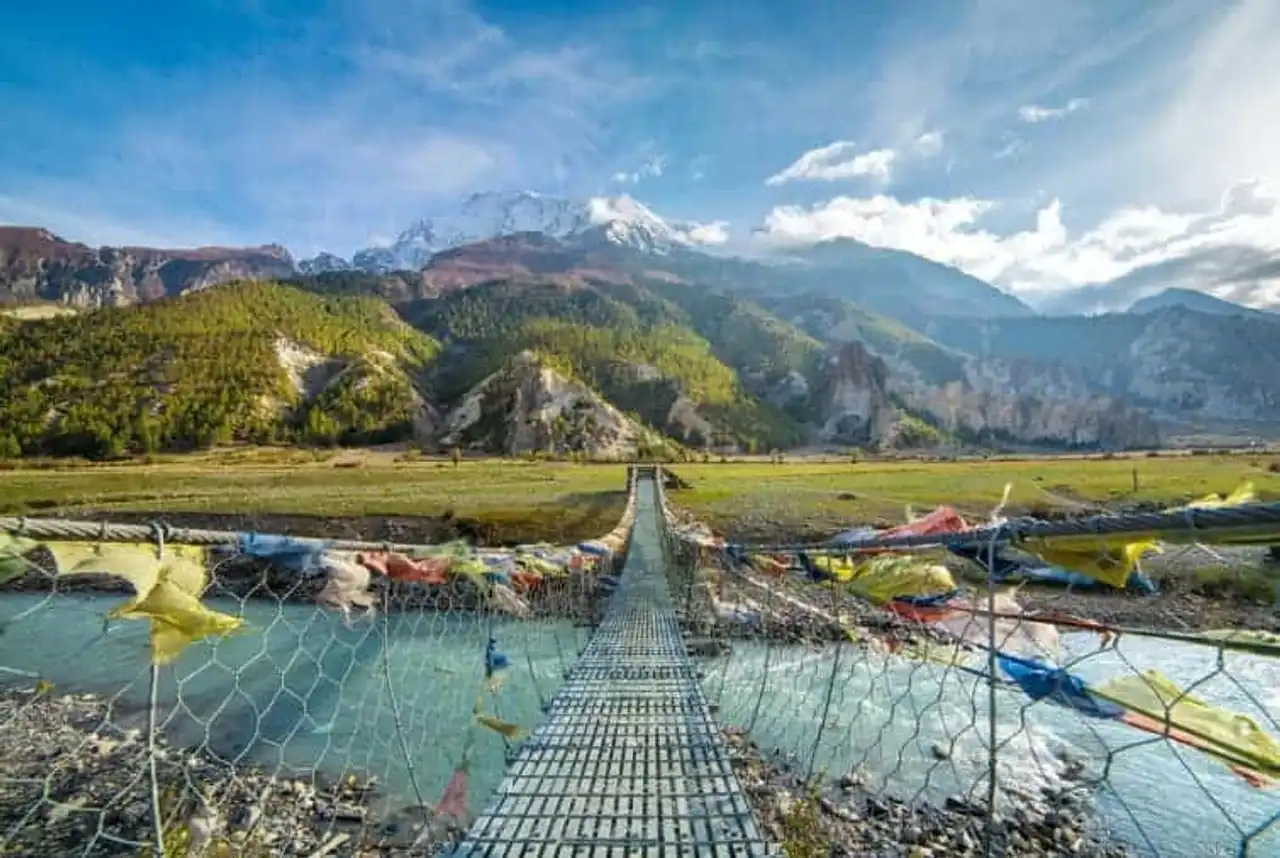
Photo credit: Shutterstock / Mazur Travel
The various routes possible
In Nepal, not all hikes are marked precisely, and it is always possible to adapt the route, provided that it is decided by a guide or that it has already been followed and considered practicable by other trekkers. As a general rule, departures are made Bhulbhule, Jagat or Dharapani. If you leave this last point, your trek will be shorter. Indeed, you will already start it at an altitude 1,943 m instead of 830 m Bhulbhule. As far as the point of arrival is concerned, it is often recommended to finish the hike to Jomsom. However, between the base camp of Tilicho and Jomsom, the steps may vary.
Whatever the route you choose, you will not pass next to the essential steps, who make the fame of this Nepalese trek. After your arrival in Kathmandu from Paris, and your bus and jeep transfer to your starting point, here are the steps you should not miss.
Key steps to go
Dharapani-Chame : From your first day of walking, you'll already have a nice preview of what awaits you. In just an hour’s walk, you will discover the Annapurna I. You will cross a pine forest and typical villages, and will contemplate Buddhist monuments. The arrival of the stage is the village of Chame, whose population is predominantly Tibetan.
Duration: 5 h
Positive: 900 m
Altitude of Chame: 2600 m
Chame-Pisang: Between Chame and Pisang, you will be bathed in culture gurung and its many villages. The vegetation will be rarer and the terraced crops will gradually disappear, while the Himalayas chain will be more imposing. Once in the village mananghi Pisang, don't miss walking in the old town and visiting the monastery. Pisang is cut into two parts, the Upper Pisang remains the most authentic.
Duration: 5.30 a.m.
Positive: 750 m
Altitude of Pisang: 3200 m
Pisang-Manang: During this stage, you will venture on the sides of the Annapurna II and pass through the village of Braga and its monastery. The finish in Manang is impressive. You will see the beautiful summits of Annapurnas II, III and IV, Pisang Peak and Masnulu. Manang will take you back to the tourist atmosphere, with a large concentration of restaurants and shops of all kinds.
Duration: 5 h
Positive: 240 m
Altitude of Manang: 3 540 m
Manang-Kangshar: This step is shorter. Thus, it will allow you to take a little rest, before attacking the ascension that will give you the opportunity to admire the lake of Tilicho, located at 4,919 m above sea level. The Trek of the Tour des Annapurnas does not pass through the stretch of water, but offers a breathtaking view of this glacial lake of an incredible blue. You will finish your stage in Kangshar and will not miss visiting her gompa .
Duration: 3 h
Positive: 240 m
Altitude of Kangshar: 3800 m
Kangshar-Camp base of the Tilicho: The path to the base camp of the Tilicho is narrow enough. You will pay attention to the many stones that at any time risk to devaluate the steep slopes of these landscapes to the lunar atmosphere.
Duration: 7 a.m.
Positive: 360 m
Altitude of the Tilicho base camp: 4200 m
The variants of the return
The uncontournable return is unquestionably the passage of the pass of Thorong-La (5,416 m) , which is the highest pass of the trek of the Tour des Annapurnas. Apart from this step, you have several options.
Route A: Tilicho base camp, Yak Kharka, Phedi, Muktinath, Jomsom
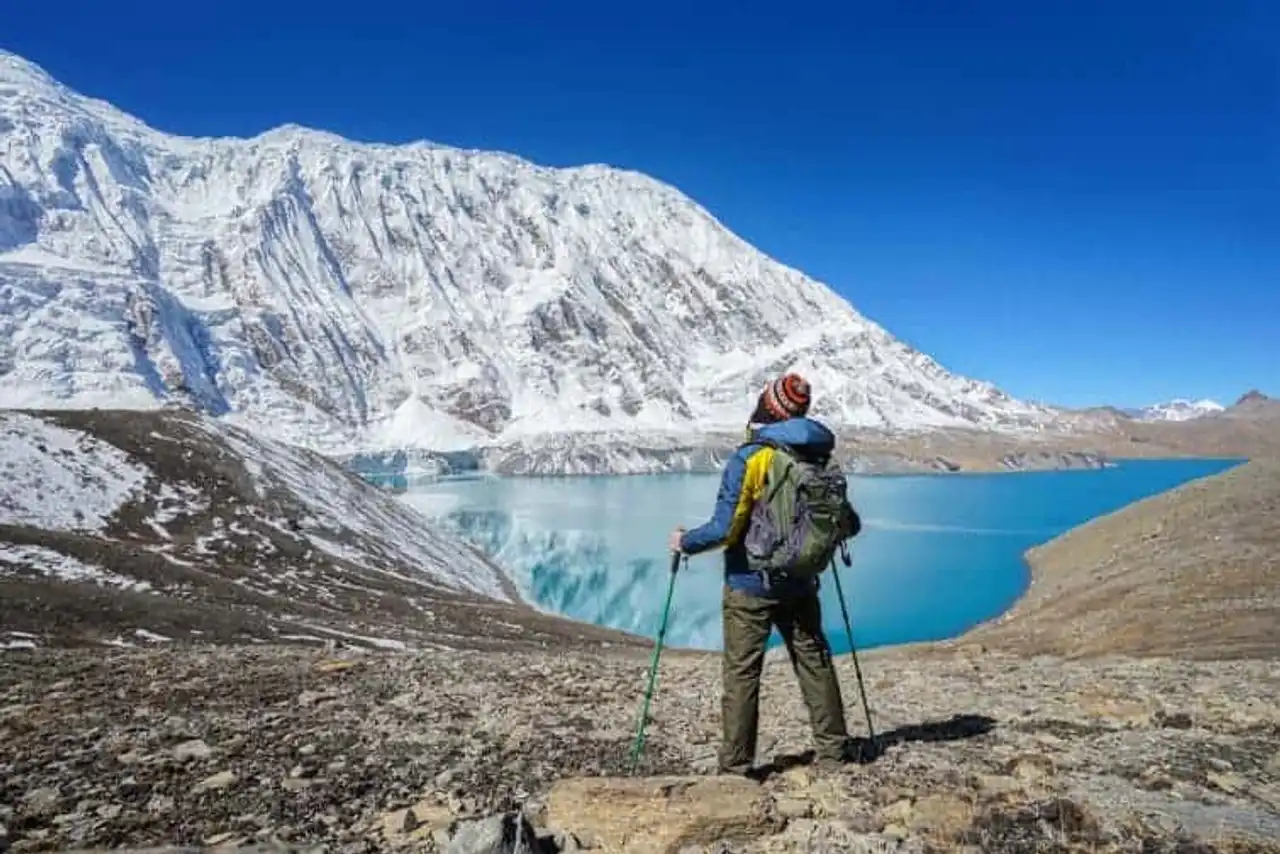
Photo credit: Shutterstock / Upslim
-
Tilicho-Yak Kharka Base Camp: During this stage, you can probably see herds of yaks and goats, as well as vultures, before arriving in the village of Yak Kharka.
Duration: 6 a.m.
Positive: 250 m
Altitude to arrival : 4010 m -
Yak Kharka-Phedi: From Yak Karkha to Phedi, you will be between water and rock, as you will follow lakes and waterfalls, in a dry landscape, with the Himalayas as a backdrop. A step in Phedi will allow you to acclimatize more easily and avoid the acute evil of the mountains.
Duration: 5 h
Positive: 400 m
Altitude to arrival : 4450 m -
Phedi-Muktinath: Before arriving in Muktinath and visiting his famous monastery, a rough day awaits you! This passage is probably the most difficult of the Tour des Annapurnas trek, since you will have to cross the Thorong-La pass. The descent to the finish will not be easier. You'll deserve your night off!
Duration: 8-12 p.m.
Positive: 966 m
Altitude to arrival : 3800 m -
Muktinath-Jomsom: The trek is coming to an end. To finish in beauty, you will admire the Kali Gandakhi River valley and visit Tibetan-style villages such as Kagbeni or Dagarzong. Then you’ll only have to join Jomsom to win and celebrate your well-deserved victory!
Duration: 5 a.m. to 6 a.m.
Positive: 300 m
Altitude to arrival : 2800 m
Itiniraire B : Tilicho base camp, Letdar-High Camp, Jarkhot, Jomsom
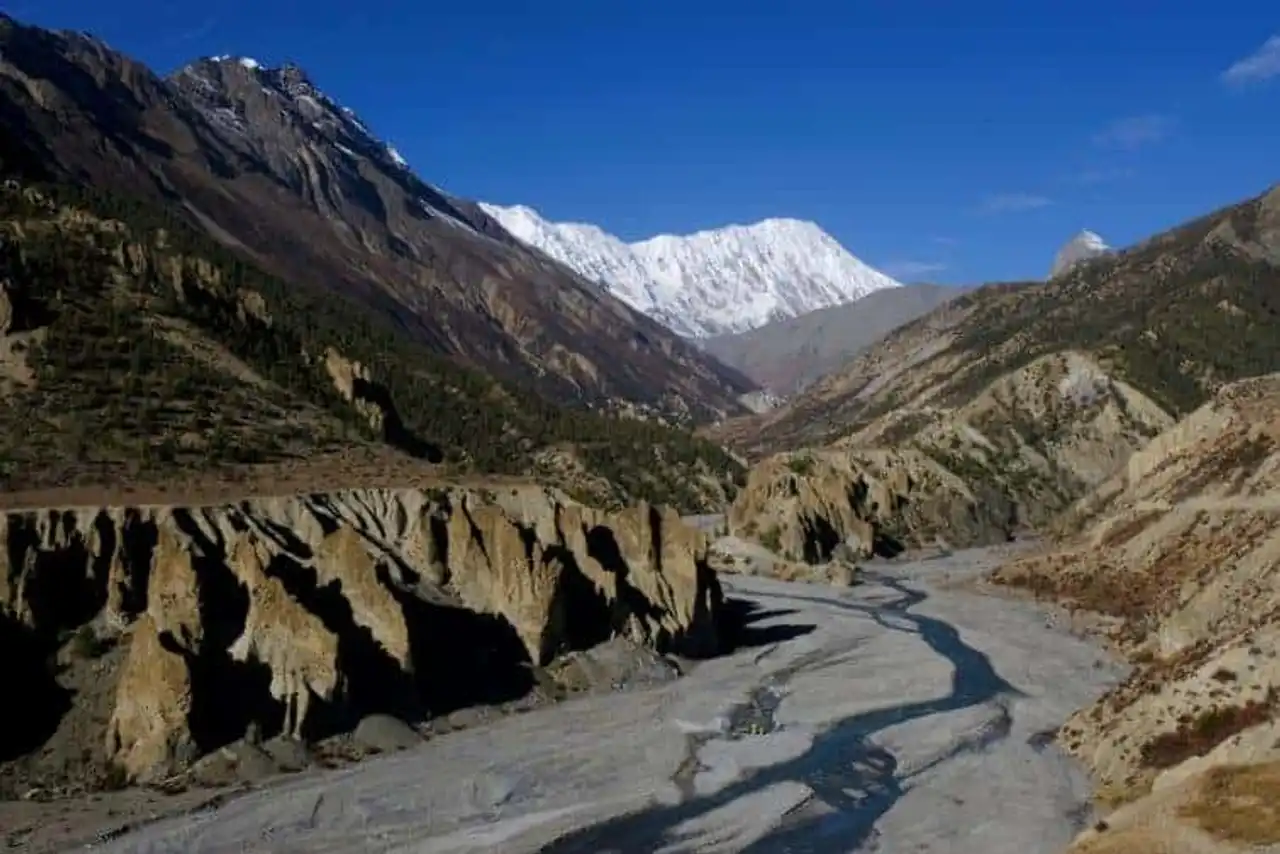
Photo credit: Shutterstock / Nichapat Yingkitphinyo
-
Tilicho-Letdar Base Camp: That pet lovers don't miss this stage! Between yaks, wild goats and vultures, your efforts will be rewarded! Although nature knows how to regain its rights, culture is never far from Nepal and you will walk on many paths surrounded by prayer flags.
Duration: 5 h
Positive: 500 m
Altitude to arrival : 4230 m -
Letdar-High Camp: Serious things start! The path leading to the High Camp deserves to take some precautions and pay attention to the landslides. Nevertheless, a superb show awaits you on arrival, with a breathtaking view of some of the tops of the Himalayan chain.
Duration: 4 h
Positive: 600 m
Altitude to arrival : 4800 m -
High Camp-Jarkhot: If you decide to sleep at the High Camp, the view is, of course, exceptional, but beware of the acute evil of the mountains. The day of walking to Jarkhot imposes to be in full shape, because the passage of the Thorong-La pass is particularly delicate. Once this difficulty has passed, you can visit the village of Muktinath and its religious monuments, before stopping in the charming village of Jarkhot.
Duration: 8 a.m.
Positive: 600 m
Altitude to arrival : 1800 m -
Jarkhot-Jomsom: Last day, don’t forget to stop at Bönpo de Lupra. You will then enjoy the return of vegetation, along the Kali Gandaki River, before reaching Jomsom.
Duration: 5 h
Positive: 400 m
Altitude to arrival : 2800 m
How much is a ticket for the Annapurnas Tour trek?
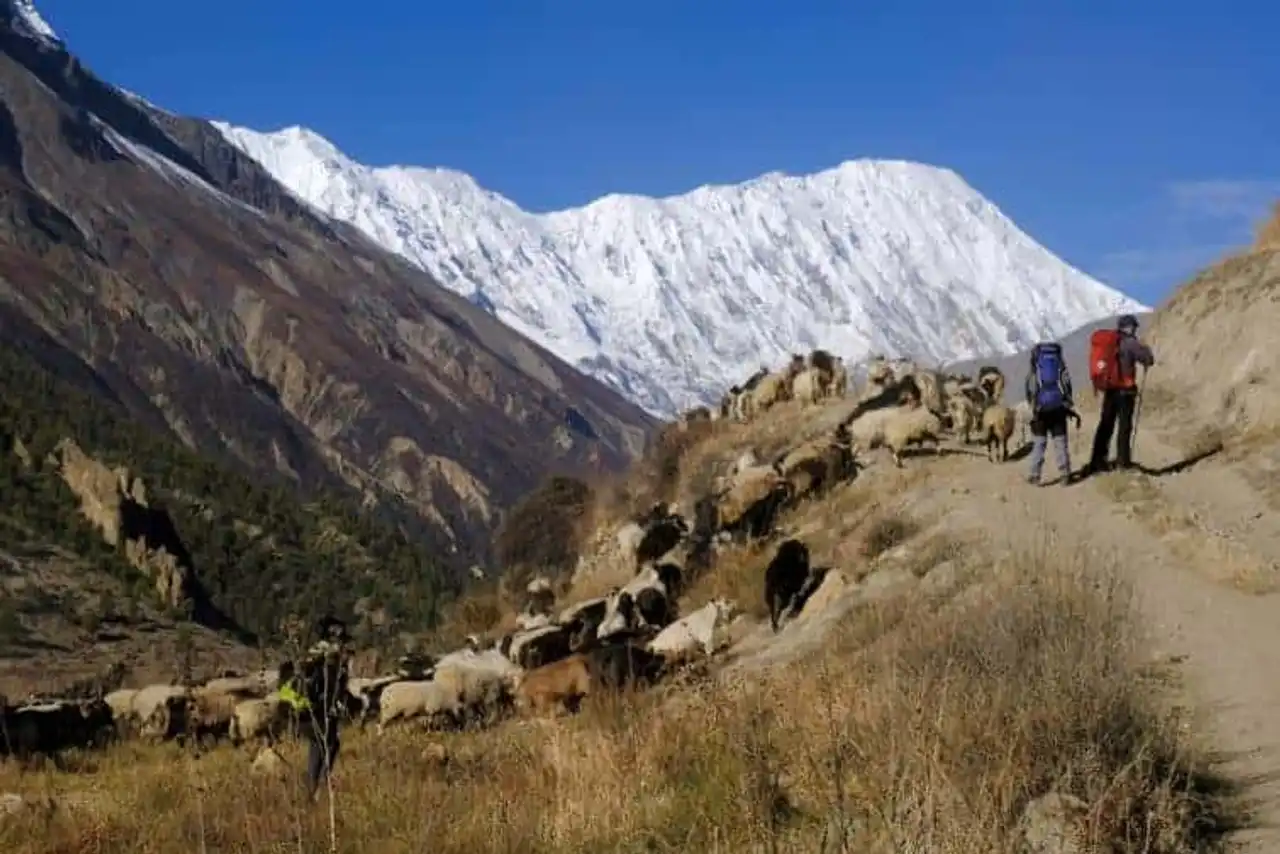
Photo credit: Shutterstock / Nichapat Yingkitphinyo
If you decide to go through a French agency, between 2 300 and 3 000 €, from France. If you are already in Nepal, the tour with a guide and a sherpa found on site will cost you around 800 €. Nevertheless, it is always possible to lower prices. Without a guide and without a sherpa, you should get out of it 400 € per maximum person, knowing that one eats as an ogre for four euros!
The next steps
To make the Tour des Annapurnas trek, you will not leave Kathmandu on foot! Indeed, the Annapurnas massif is located more than a hundred kilometers from the Nepalese capital. Therefore, while walking starts only in Bhulbhule, Jagat or Dharapani, you must take into account the additional steps, annexes, but indispensable:
- Night in Kathmandu, after your arrival in France;
- night at the starting point of your trek in Nepal, that you have joined by bus and/or jeep, directly from Kathmandu;
- night at the arrival point of your trek;
- night in Pokhara;
- night in the capital, before leaving for France.
Therefore, make sure to add a minimum of four additional nights, to calculate the total duration of your trek in Nepal, in addition to walking days.
How to book an online ticket for the Tour des Annapurnas trek?
- In Nepal: If some trekkers like to take care of themselves, it is recommended to make the Tour des Annapurnas accompanied by a guide, and possibly a sherpa. Therefore, you will have to go through a Kathmandu agency. In the capital of Nepal, trekking agencies are not missing! They offer approximately the same prices and benefits. On the other hand, you don’t have a salesman from the corner of the street, who doesn’t have offices presentable.
- From France: You can book your tickets online from France on recognized tour operators sites or specialized tour guides.
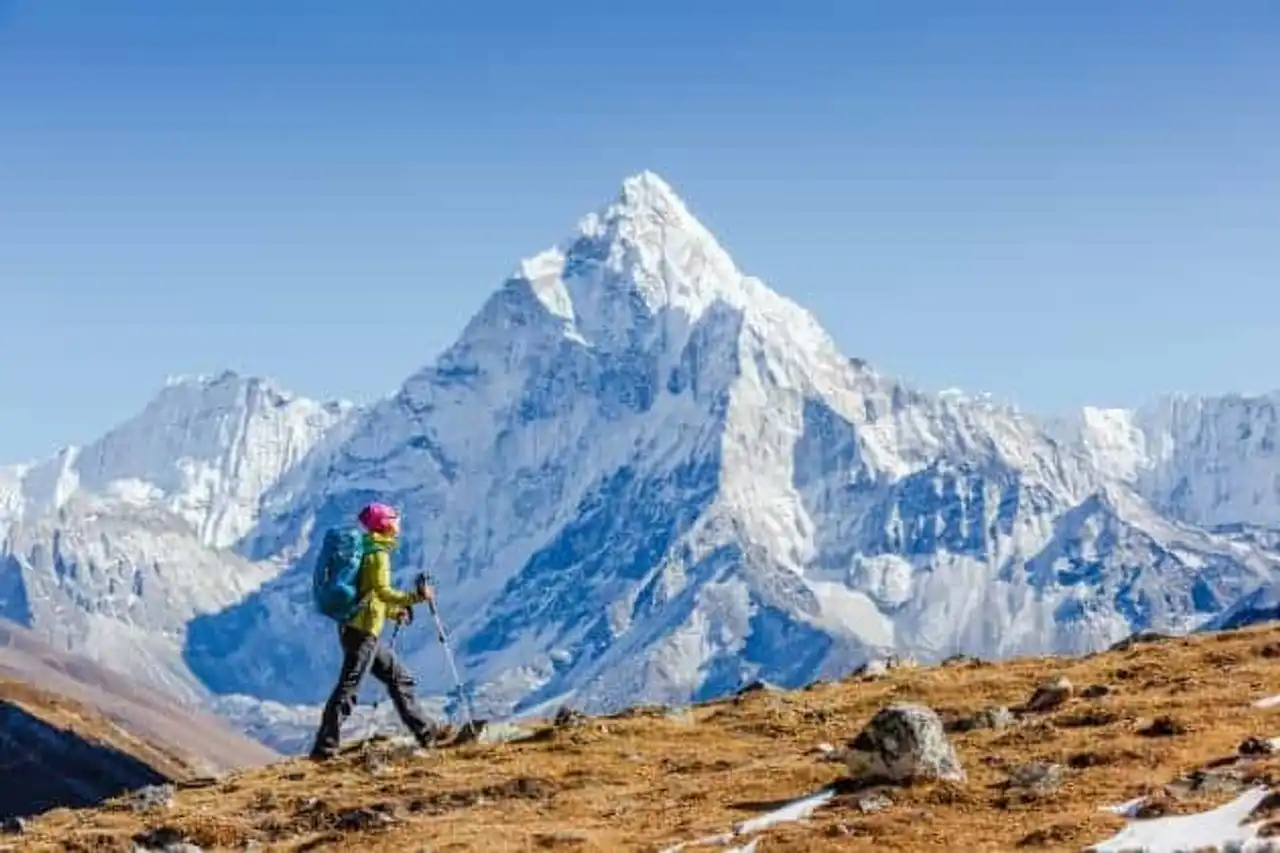





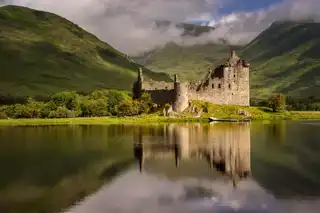
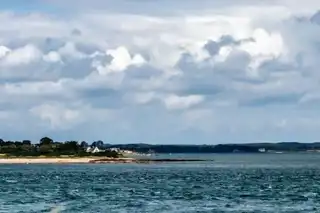
Loading comments ...